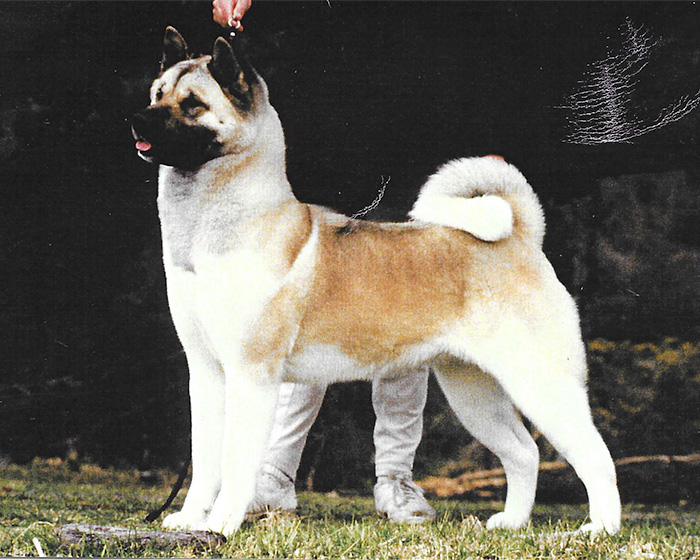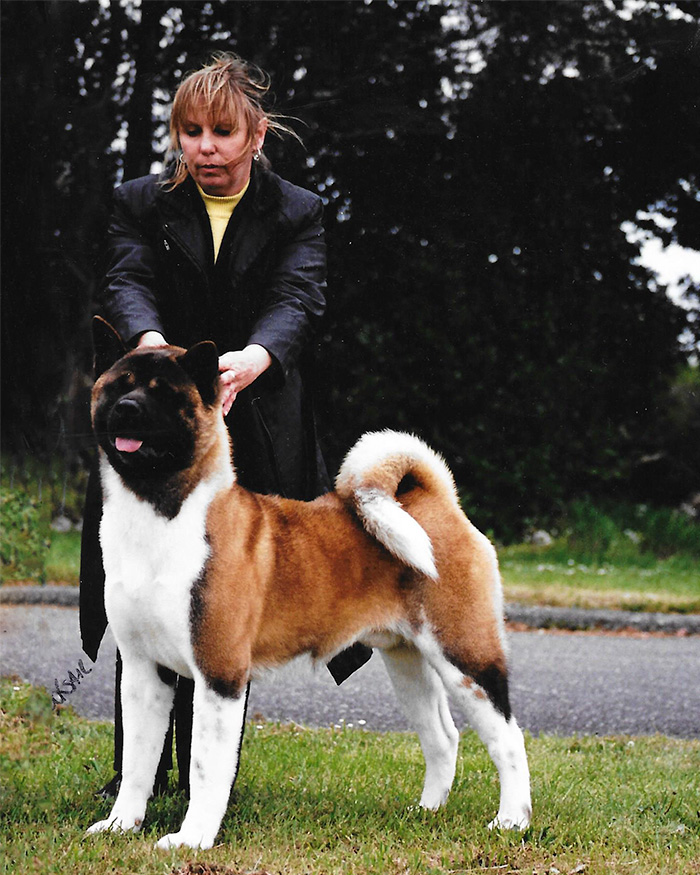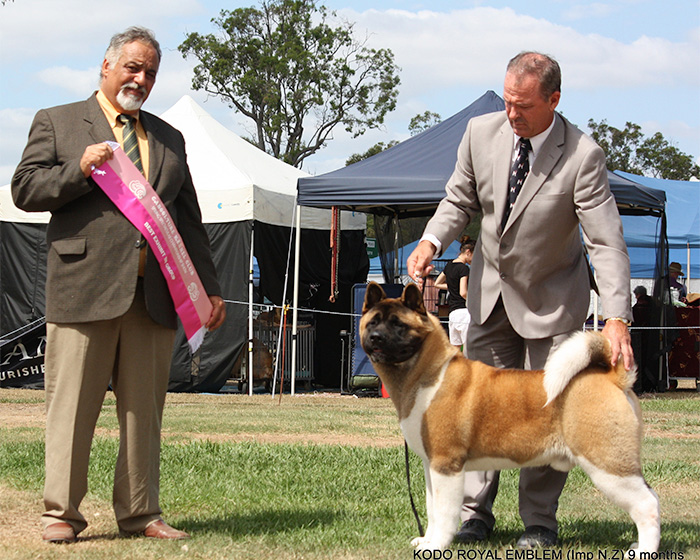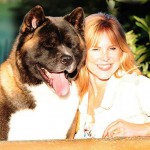Kodo American Akitas
Interview with Mrs. Margaret Hippolite • Interviewed by Mihaela Kosic
Published in Best in Show Summer 2016
BIS: First of all thank you for taking the time to do this interview! Akitas is one of the most popular and attractive dog breeds lately. Can you please tell us about your beginnings in the breed and about your first Akita?
M.H.: Kodo Kennels have been established in Akitas since 1988, our first Akita, NZ Ch Sakura No Hana “Shedo”, was the progeny of a dam imported in whelp from the UK. Shedos sire was OBJ The Real McCoy and she was a half-sister to the famous Akita: Am Ch OBJ The Widowmaker.
BIS: When and why did you decide to breed Akita’s? How did you come up with your Kennel name? And what are your foundation dogs.
M.H.: My kennel name is a combination of my two foundation bitches Koko and Shedo.
BIS: How many dogs do you have? Do you prefer to keep your dogs with you, or place them in families and co-ownerships?
M.H.: I only have 4 at home now but several placed in co-ownership arrangements both in New Zealand and Australia.
BIS: Do you work with other kennels? Are collaborations between kennels in your opinion necessary for the betterment of the breed?
M.H.: I am lucky to have a network of kennels in Europe, USA and Australia to work in with. No man is an island and this is also the case when breeding dogs.

BIS: Do you have a role model in the breed? Who do you admire the most in the breed? Did you have a mentor at your beginnings?
M.H.: I was fortunate to have friends and mentors in the breed from the early days. My first import Akita was from Dave and Jenny Killilea of Redwitch Akitas, who are lifelong friends and mentors. Our early correspondence was by “letter”, there was no internet in those days. I still have all the letters and hand written pedigrees. I was fortunate to import five Redwitch Akitas over the years which have been some of my most successful show dogs and breeding foundations.
Carol Laubscher –Regalia Akitas is also a wonderful mentor and friend. I have always attended the USA Nationals with her and learnt so much about bloodlines, movement and type. I often stayed with at her beautiful kennels.
I have great respect for Dr Sophia Kaluzniacki and her influence and knowledge with the establishment of the American Akita in the world. She assisted with information and support when we worked for the breed to be split in NZ, we were one of the first countries to split the breed in 2001.
BIS: What makes one a great breeder? What is the most important thing that a breeder should never ever forget or ignore? What makes the biggest difference between a great breeder and a “hobby” breeder?
M.H.: I could say knowledge of breed type, dedication or persistence but really I think an eye for a dog and an instinct to “see” the potential when combining bloodlines. Be honest about health issues but don’t throw the baby out with bathwater – as we say. Breeding should always be about improving and sometimes it takes time.
BIS: How many litters do you have per year? How long do you plan your breedings?
M.H.: One to two litters per year and whilst I do plan my breeding program, you have to be prepared to be flexible as nature is never predictable.
BIS: Do you prefer linebreeding, inbreeding or outcrossing?
M.H.: Never inbreeding, our gene pool is small enough already. Yes to linebreeding and occasionally outcrossing but never too often.
BIS: Do you remember your first Champion? Do you know how many Champions did you have so far? Who is your biggest winner (your own dogs, and your bred dogs)?
M.H.: My first Champion was my Mc Coy daughter.Under the KODO prefix I have had over 40 Australian and New Zealand Champions, with 5 Grand Champions and Akitas I have breed or owned have won 32 Best In Show awards at Championship level.
BIS: What is your most memorable win?
M.H.: My most memorable win was as a junior handler in 1994 at the NZKC National All Breeds show with a bitch called“Kiri” NZ Ch Redwitch High Hopes (Imp UK). I went in with no expectations; we had won several Puppy In Shows but nothing major.
The judge was, Mr Andrew Brace from the UK and all the top dogs were there, we won the best of breed and then to my great delight where awarded Group 1. I felt so privileged that such an esteemed judge had recognized the qualities I knew Kiri had, this is 1994 and the breed was very new here. “Kiri” went on to win 3 All Breed BIS and many more groups awards she really did have that “X” factor
BIS: Do you think the breed changed and evolved in a good or bad way in the past years?
M.H.: I have seen huge improvements over the past 30 years in the breed with type and structure. However we are losing size and very rarely see the masculine Akita in the males from the past.
BIS: Do show trends change the breed and if so in what way?
M.H.: I think they do, just take a look at the rings now full of “flashy” Akitas. The standard says “ANY colour including white, brindle and pinto…brilliant, clear, well balance”. At some shows you would think white legs, tails and white chests are part of the standard.
BIS: What qualities do you admire in breed specialist judges?
M.H.: Attention to detail but it can also be a negative if not balanced by looking at the whole dog.
BIS: Do you think the Standard is a good one?
M.H.: Our standard may be different to FCI but it is a good standard with many measurable aspects.

BIS: Can “all round” judges change the breed and the breed “trends” if they don’t understand the Standard correctly?
M.H.: Only if breeders are easily influenced which we would hope they are not.
BIS: What can be done to improve the judging?
M.H.: Education and physically attending specialties and seminars not just in your own geographical area
The USA specialty always has a judges education seminar and selected breed mentors sit with judges during the show discussing aspects of the standard.
BIS: What are your long-term goals in breeding?
M.H.: Always to improve the breed both in health and type. I think like many breeders I am always striving to produce that one “stand-out” Akita, that once in a lifetime dog that fits my perception of the breed standard. It’s an almost unreachable goal but very rewarding trying to achieve it.
BIS: What is the most important thing you would never compromise in your breeding program?
M.H.: A serious health issue.
BIS: Do you feel that you have established a distinguishable line? Would you say you have a recognizable kennel type?
M.H.: Judges have recognized Akitas from my kennel without knowing they are mine, so yes.
BIS: A huge part of Akita’s popularity is their temperament. In your own words how would you describe a perfect Akita temperament?
M.H.: Well I don’t have to describe it in my words as the standard describes it and we should be breeding to that? The Australian standard says “Dignified, courageous, aloof tends to show dominance over other dogs, though the trait is not encouraged”.

BIS: Do you health test your dogs?
M.H.: Yes although I am not convinced that hip scoring is an accurate a tool as it is believed to be.
BIS: What do you think about the trend of breeding to “popular” Champion studs?
M.H.: It depends on the “stud”, if he has a lot of good qualities that he is passing on then it would be an asset however as mentioned previously we have a very small gene pool and it is something that needs to be considered.
BIS: How do you choose the studs you use? And how important is a pedigree in your breeding program?
M.H.: Pedigree is always considered. I very rarely use a dog that is not linebred. I tend to look at what the dog has produced rather than what he looks like himself. If I see a dog I like I always look at the sire and other progeny from that sire.
BIS: Last but certainly not the least what advice would you give to new generations, first time owners, one day possible Akita breeders?
M.H.: Listen to everyone but make up your own mind. Breeding is like writing a book…it happens chapter by chapter, don’t expect to write an award winning novel straight off. Above all love your akita!



